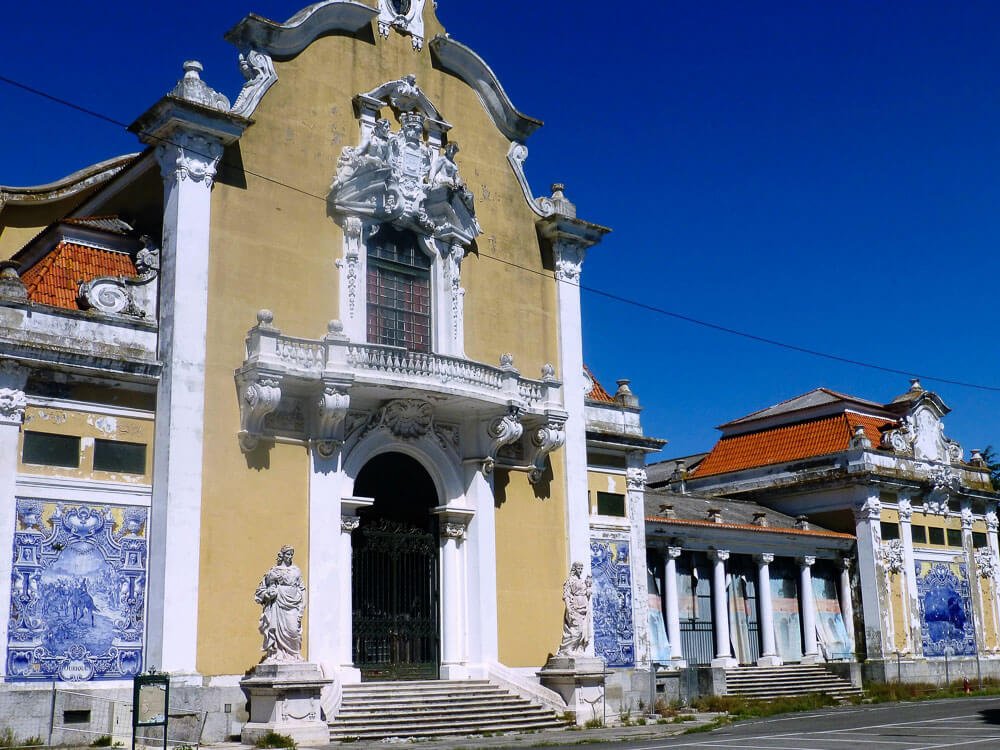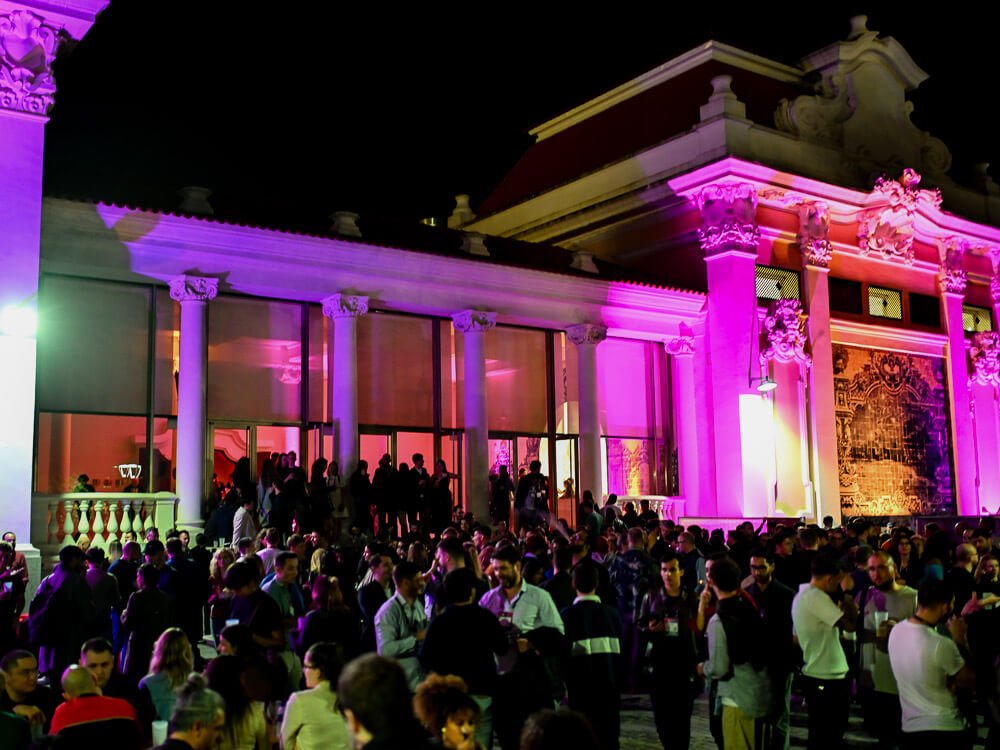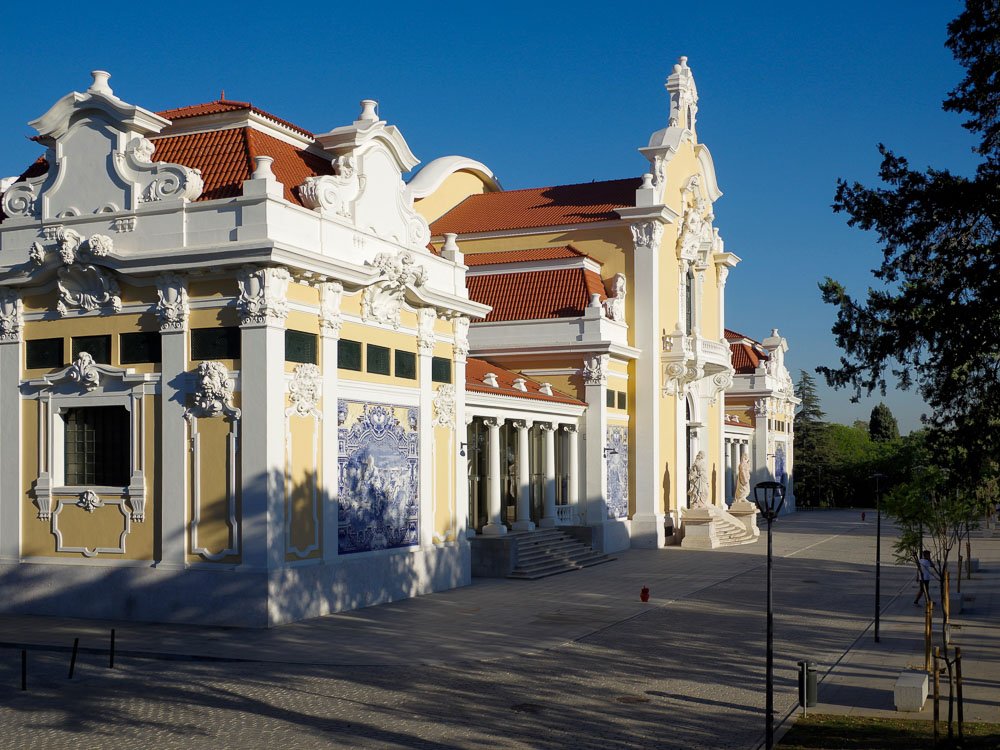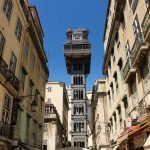The Carlos Lopes Pavilion in Lisbon is a stunning building as well as a venue for exhibitions, sporting and cultural events. Here’s everything you need to know before visiting it!
It’s impossible to walk through Parque Eduardo VII without noticing the Pavilhão Carlos Lopes, or Carlos Lopes Pavilion, with its detailed tiled exterior and distinctive architecture. Ask anyone, they’ll agree with me!
This striking building has been a venue for exhibitions, sporting events and other cultural activities since the 1930s. It became so emblematic in the sports scene that it was renamed to honor the first Portuguese athlete to win an Olympic gold medal, Carlos Lopes, in 1984.
The Carlos Lopes Pavilion is one of those hidden gems in Lisbon that you just have to see for yourself. So, in this guide I’ll tell you everything there is to know about this landmark so you can enjoy your visit to the maximum.
Carlos Lopes Pavilion – In a nutshell
- Highlights: blue-and-white ceramic tilework, Carlos Lopes museum, various events
- Opening hours: 10am to 6pm
- Tickets/price: free
- Recommended duration of visit: 30 min – 1h
- Address: Avenida Sidonio Pais 16, Marques de Pombal, Lisbon, 1070-051
- Nearest metro station: Marquês de Pombal (blue and yellow lines) and Parque (blue lines)
Index
- History
- Points of interest
- How to get to Carlos Lopes Pavilion?
- When to visit and how long to stay?
- Where to stay near Carlos Lopes Pavilion?
- Attractions nearby

1. History
The Carlos Lopes Pavilion dates back to the early 20th century, when it was designed to represent Portuguese culture and industry in the 1922 Rio de Janeiro Expo. Once its role in Brazil was over, the structure was shipped back to Lisbon and rebuilt, this time in the Parque Eduardo VII.
Back when it first reopened, in 1932, it was called the Palace of Exhibitions, and hosted the Portuguese Industrial Exhibition. Soon after that, several other cultural, artistic, political and sporting events began taking place there, including the World Championship of Roller Hockey, in 1947.
Due to its importance in the sporting world, the pavilion was renamed in 1984 to honor Carlos Lopes, who won the marathon in the Los Angeles Olympics, becoming the first Portuguese athlete to do so.
In 2003, the pavilion was closed and restored in order to maintain its historical features while also adapting it for modern use. It reopened to the public in 2017, and is now managed by the Lisbon Tourist Association, hosting exhibitions, conferences and private events.
1.1. Architecture and modern facilities
Carlos Lopes Pavilion was designed by the architects Carlos and Guilherme Rebelo de Andrade. With its square layout and eclectic architectural style, it’s an example of revivalist design, with influences of Johannine Baroque style.
The pavilion’s architecture is truly what makes it stand out amidst the trees of the Parque Eduardo VII. You don’t even need to go inside to see how impressive it is: the exterior itself is a work of art, covered with traditional azulejos representing scenes of Portugal’s history.
In 2016, the building underwent significant renovation to modernize its facilities while preserving the original architectural features. This resulted in a more accommodating and modern space without losing its historical elements, making it suitable for all kinds of events, from meetings to product launches.

2. Points of interest
2.1. Artistic elements
As I mentioned earlier, the main façade of the Carlos Lopes Pavilion features a tribute to Portuguese art and history through traditional blue-and-white tile panels produced by Fábrica de Sacavém in 1922. But that’s not all the art you’ll get to see at the pavilion!
Inside, you’ll find walls lined with beautiful tile panels created by artists Jorge Colaço and Jorge Pint, while at the front stand the sculptures “Art” and “Science”, by Raul Xavier, representing aspects of human progress over time.
2.2. Engaging with local customs
To visit the pavilion, you need to go to Parque Eduardo VII, one of the most famous green spaces in Lisbon. This is where locals, tourists and expats gather to enjoy all kinds of outdoor activities, like reading, meeting friends, having picnics and walking dogs.
Spending time at the park gives you the opportunity to experience Lisbon from a local’s perspective, away from the usual tourist crowds. So, if you want to engage with local customs and get a taste of the Lisbon lifestyle, then I highly recommend visiting the Carlos Lopes Pavilion and the Parque Eduardo VII.
I’m sure you’ll leave with a newfound appreciation for Lisbon’s sense of community and its welcoming atmosphere!
2.3. Exhibitions and events
The Carlos Lopes Pavilion is a very versatile venue, hosting a lot of temporary exhibitions and public and private events throughout the year. It’s not uncommon for it to host cultural performances, political meetings, conferences and festivals of all kinds, so it’s very likely that you’ll find something that spikes your interest.
Besides that, the pavilion also has a permanent exhibition focused on Carlos Lopes, the athlete honored in the building’s name. It showcases his life and achievements, displaying items like his trophies and even the running shoes he wore to the Los Angeles Olympics marathon.

3. How to get to Pavilhão Carlos Lopes?
The pavilion is well-connected by public transport, which means getting there is very easy. If you decide to use the metro, the park is within walking distance from two stations: Marques de Pombal, serving the blue and yellow lines, and Parque, on the blue line.
You can also take the bus, as there are several numbers that stop near Parque Eduardo VII, such as 207, 726, 744, 746, 783. So, no matter where you are in Lisbon, you won’t have any trouble reaching the Carlos Lopes Pavilion!
4. When to visit and how long to stay?
The Carlos Lopes Pavilion is open every day from 10am to 6pm and offers free entrance. If you want to attend special events or temporary exhibits, make sure to check their schedule beforehand.
As for how long it takes to visit the pavilion, it depends. On a typical day, it should take from 30 minutes to an hour to view the permanent exhibit, the panels and the architecture. However, if you’re going to a specific event or exhibition, you may want to spend a bit more time there.

5. Where to stay near Carlos Lopes Pavilion?
If you want to stay in a central location that has plenty of dining options and is well-connected by public transportation, then choosing an accommodation near Carlos Lopes Pavilion is exactly what you need! Here are my hotel suggestions in this area:
- TURIM Europa Hotel: a 4-star hotel located just a 5-minute walk away from Marquês de Pombal Square in central Lisbon. It offers modern, air-conditioned rooms with free Wi-Fi and stylish decor. The hotel has a restaurant, a bar, a reading room and a TV room. It also offers 24-hour reception, and laundry facilities, making it a comfortable and convenient choice for travelers.
- HF Fenix Urban: a 4-star hotel centrally located in Lisbon, just a short walk to Parque Eduardo VII and Avenida da Liberdade. The rooms have free Wi-Fi, contemporary decor, flat screen TVs and a minibar. The hotel offers daily breakfast, which you can enjoy at the restaurant or in-room.
- H10 Duque de Loule: this charming hotel is conveniently located, just 500m from Avenida da Liberdade, and offers air-conditioned rooms with free Wi-Fi and amenities such as a coffee machine, hairdryer, and free toiletries. There’s a 24-hour front desk, a terrace, a restaurant and bar. Other amenities include a shared lounge, ticket service, and tour desk.
- WOT Lisbon Patio: a great budget-friendly option, this hostel is conveniently located, just 1.1km from Avenida da Liberdade. It offers various amenities, such as a terrace, shared lounge, bar, free Wi-Fi and daily continental breakfast. The rooms offer city views and some have private bathrooms, and the 24-hour front desk staff speak English and Spanish.
6. Attractions nearby
Since the pavilion has a very central location, there’s no shortage of things to do in the surrounding area. Just a short walk away is Avenida da Liberdade, where you’ll find upscale designer shops, theaters, and restaurants.
The pavilion is in Parque Eduardo VII, a quiet space away from city noise, with well-maintained lawns and hedges. It’s perfect for picnics, walks and appreciating the cityscape towards the Tagus River.
Also nearby is Praça do Marquês de Pombal, an important traffic hub that is best known for its monument honoring Marquis of Pombal, the responsible for reconstructing Lisbon post-1755 earthquake.
And, if you want to grab a bite before heading to your event at the pavilion, you can visit El Corte Inglés, just a short walk away. This department store presents various shopping options, including high-end brands and specialty food sections. I highly recommend checking it out!
Ready to spend an unforgettable afternoon at the Carlos Lopes Pavilion?

Carlos Lopes Pavilion is a must-visit attraction for everyone, whether it’s their first or fifth time in Lisbon. There, you can visit the Carlos Lopes exhibit and enjoy the pavilion’s distinctive architecture even from the outside, with its incredible tile panel.
While it primarily serves as a venue for conferences and private events, occasionally the pavilion hosts public exhibitions showcasing culture and art. This allows visitors to go inside Pavilhão Carlos Lopes and see what it offers beyond the façade.
For a full experience, I recommend visiting Parque Eduardo VII along with Carlos Lopes Pavilion. These two truly complement each other, offering a delightful mix of culture and nature that will make you love Lisbon even more!







